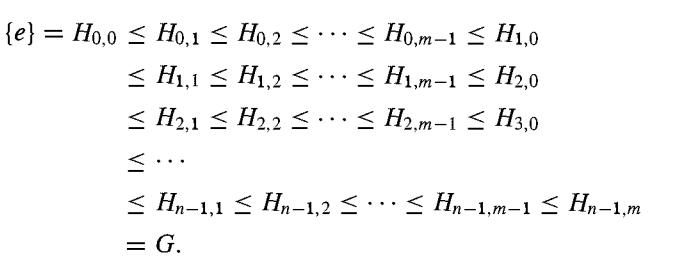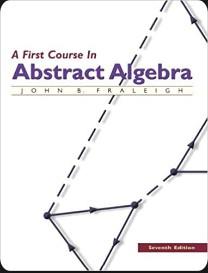Let G be Z 36 . Refer to the proof of Theorem 35.11. Let the subnormal series
Question:
Let G be Z36 . Refer to the proof of Theorem 35.11. Let the subnormal series (1) be {0} < (12) < (3) < Z36 and let the subnormal series (2) be {0} < (18) < Z36. Find chains (3) and (4) and exhibit the isomorphic factor groups as described in the proof. Write chains (3) and (4) in the rectangular array shown in the text.
Data from Theorem 35.11
Two subnormal (normal) series of a group G have isomorphic refinements. Proof Let G be a group and let {e} =H0< H1 < H2 < · · · < Hn = G and {e} = K0 < K1 < K2 <· · · < km = G be two subnormal series for G. For i where 0 ≤ i ≤ n - 1, form the chain of groups Hi = Hi(Hi+1 ∩ K0) ≤ Hi(Hi+1 ∩ K1) ≤ · · · ≤ Hi(Hi+1 ∩ Km)= Hi+1.This inserts m -1 not necessarily distinct groups between Hi and Hi+1. If we do this for each i where 0 ≤ i ≤ n - 1 and let Hij = Hi(Hi+1 ∩ Kj), then we obtain the chain of groups

This chain (3) contains nm + 1 not necessarily distinct groups, and Hi,0 = Hi for each i. By the Zassenhaus lemma, chain (3) is a subnormal chain, that is, each group is normal in the following group. This chain refines the series (1). In a symmetric fashion, we set Kj,i = Kj(Kj+1 ∩ Hi) for 0 ≤ j ≤ m - 1 and 0 ≤ i ≤ n. This gives a subnormal chain

This chain ( 4) contains mn + 1 not necessarily distinct groups, and Kj,0 = Kj for each j. This chain refines the series (2). By the Zassenhaus lemma 35 .10, we have Hi(Hi+1 ∩ Kj+1) Hi(Hi+1 ∩ Kj) ≈ Kj(Kj+1 ∩ Hi+1)/Kj(kj+1 ∩ Hi), or Hi,j+1/Hi,j ≈ Kj,i+1/Kj,i for 0 ≤ i ≤ n - 1 and 0 ≤ j ≤ m - 1. The isomorphisms of relation (5) give a one to-one correspondence of isomorphic factor groups between the subnormal chains (3) and (4). To verify this correspondence, note that Hi,0 = Hi and Hi,m = Hi+1, while Kj,0 = Kj and Kj,n = Kj+1· Each chain in (3) and (4) contains a rectangular array of mn symbols ≤. Each ≤ gives rise to a factor group. The factor groups arising from the rth row of ≤'s in chain (3) correspond to the factor groups arising from the rth column of ≤'s in chain (4). Deleting repeated groups from the chains in (3) and (4), we obtain subnormal series of distinct groups that are isomorphic refinements of chains (1) and (2). This establishes the theorem for subnormal series.
For normal series, where all Hi and Kj are normal in G, we merely observe that all the groups Hi,j and Kj,i formed above are also normal in G, so the same proof applies. This normality of Hi,j and Kj,i follows at once from the second assertion in Lemma 34.4 and from the fact that intersections of normal subgroups of a group yield normal subgroups.
Step by Step Answer:






